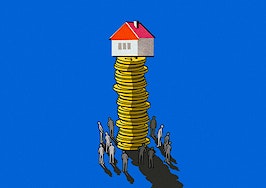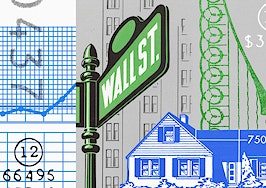This report is available exclusively to subscribers of Inman Intel, the data and research arm of Inman offering deep insights and market intelligence on the business of residential real estate and proptech. Subscribe today.
Homeowners with mortgage rates higher than 5 percent were three times as likely as those with sub-3.5 percent rates to report a strong willingness to enter the home market over the next 12 months, according to a wide-ranging survey conducted by Intel.
The Inman-Dig Insights consumer survey confirms the so-called “rate lock-in” effect is very real — and has implications for both the housing market broadly and the brokerage world’s transition to a new business landscape.
It also produced a series of nuanced insights into how mortgage rates can influence a wide variety of client attitudes toward the present moment in housing.
Conducted in early April, the survey interviewed 3,000 employed U.S. consumers, including 1,172 homeowners with a mortgage who shared details about the rate on their current loan.
That subgroup was of particular interest to Intel.
Having confirmed the existence of the rate lock-in effect, Intel set out to explore its contours and limits — as well as identify how the next wave of brokerage clients thinks about working with agents in the wake of the NAR settlement.
Explore Intel’s findings in the full report below.
Sellers are locked — but how tightly?
For this analysis, Intel examined three distinct, similar-sized tiers of survey respondent:
- Homeowners with a mortgage rate over 5 percent
- Homeowners with a mortgage rate between 3.5 percent and 5 percent
- Homeowners with a mortgage rate below 3.5 percent
Each tier made up roughly a third of respondents with a mortgage. To better understand how mortgage rates affect consumer attitudes, Intel excluded renters and consumers who own their home outright from this analysis.
Breaking out consumers in this way produced an immediate takeaway: Homeowners with higher rates are much more interested in participating in the home market in the coming months.
And homeowners with ultra-low rates from the early pandemic era express very little interest in diving into the market.
Share of homeowners who say they are “very likely” to buy a home in the next 12 months, by mortgage-rate tier:
- Over 5% rate — 20% are “very likely” to buy
- 3.5%-5% rate — 13% are “very likely” to buy
- Sub-3.5% rate — 7% are “very likely” to buy
Share of homeowners who say they are “very unlikely” to buy a home in the next 12 months, by mortgage-rate tier:
- Over 5% rate — 43% are “very unlikely” to buy
- 3.5%-5% rate — 45% are “very unlikely” to buy
- Sub-3.5% rate — 54% are “very unlikely” to buy
It’s clear that the upper-tier group, whose rates on their current loans are closest to the prevailing rate on the market, are significantly more enthusiastic about buying than the other two groups.
But putting enthusiasm aside, the second tier of consumer — homeowners with a mortgage rate between 3.5 percent and 5 percent — are not particularly opposed to buying.
Only the final tier, sitting on the ultra-low rates from the early pandemic era, demonstrate a pure “locked in” mentality.
- 19 percent of homeowners with sub-3.5% mortgage rates report being at least somewhat likely to buy in the next 12 months.
- That’s compared to 34 percent of homeowners with a greater than 5% rate who say they’re at least somewhat likely to buy soon, and 28 percent in the middle tier who provided the same response.
A flexible bunch
Each of these three groups contained a multitude of diverse household characteristics, making it difficult at times to draw conclusions from them about where the housing market might be headed.
The three tiers all had a similar income distribution, for instance, with members spanning the full spectrum from financially strained to high-earning.
Still, one area stands out as a clear differentiator between the groups: Households with higher mortgage rates are more plugged into the NAR settlement news, and more likely to favor certain approaches for dealing with real estate agents.
Share of homeowners with a mortgage who had heard of the NAR settlement in early April, by mortgage-rate tier:
- Over 5% rate — 38% were familiar with the settlement
- 3.5%-5% rate — 27% were familiar with the settlement
- Sub-3.5% rate — 23% were familiar with the settlement
We’ve already established that homeowners with a higher rate are more likely to be following the market, so this greater familiarity with the NAR lawsuit should come as little surprise.
But this higher-rate tier of potential seller is also more likely to have a positive impression of the new post-settlement landscape — and how they stand to gain.
Share of mortgaged homeowners who have heard of the NAR settlement and believe it’s “good for consumers” but not for the real estate industry, by mortgage-rate tier:
- Over 5% rate — 48% say it’s good for consumers
- 3.5%-5% rate — 39% say it’s good for consumers
- Sub-3.5% rate — 43% say it’s good for consumers
Share of mortgaged homeowners who have heard of the NAR settlement and believe it’s “good for neither” consumers nor the real estate industry, by mortgage-rate tier:
- Over 5% rate — 7% say it’s good for neither
- 3.5%-5% rate — 14% say it’s good for neither
- Sub-3.5% rate — 16% say it’s good for neither
So this higher-rate cohort seems ready to do business in this new brokerage landscape, and they’re likely to be among the first to come off the sidelines when market rates dip.
But what exactly might that look like? Their priority may be flexibility.
- Homeowners with higher mortgage rates were more likely than other groups to favor a negotiated commission — with 40 percent of this higher-rate cohort opting for negotiation over a set commission, compared to 34 percent in the sub-3.5% rate tier who said the same.
- Higher-rate homeowners were also less likely to favor a flat-fee model — 25 percent of them preferred this approach, compared to 32 percent in the sub-3.5% tier.
- They were also about twice as likely as lower-rate groups to be open to an hourly rate of compensation for agents’ time, although this response choice still made up less than 6 percent of the higher-rate tier of respondents.
About the Inman-Dig Insights Consumer Survey
The Inman-Dig Insights consumer survey was conducted from April 3 to April 5 to gauge the opinions and behaviors of Americans related to homebuying.
The survey sampled a diverse group of 3,000 American adults, ranging in age from 24 to 65 and employed either full-time or part-time. The participants were selected based on a set of criteria that included age, gender and regional distribution.
Statistical rigor was maintained throughout the study, and the results should be largely representative of attitudes held by U.S. adults with full- or part-time jobs. Both Inman and Dig Insights are majority-owned by Toronto-based Beringer Capital.













